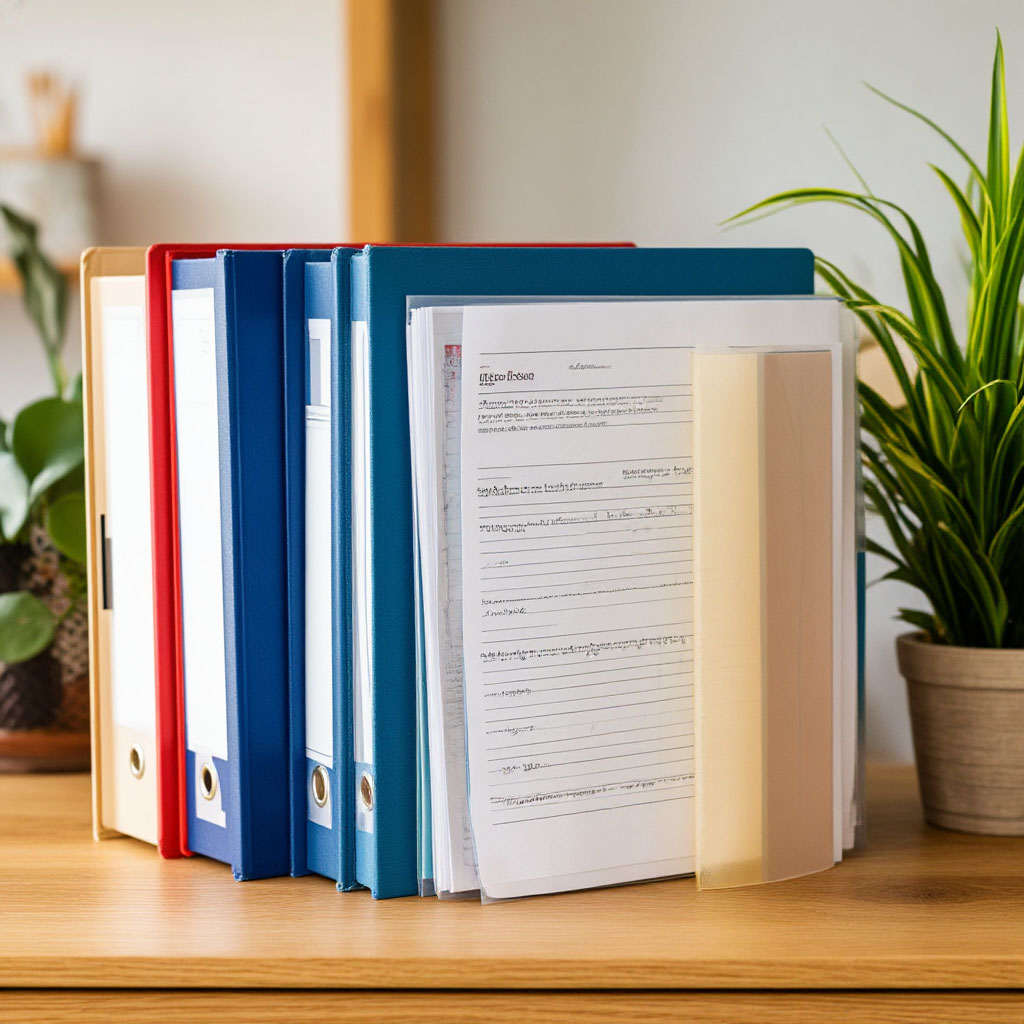Are you organizing your documents but unsure whether to choose files or folders? The choice depends on how many papers you need to store, how often you access them, and how important it is to keep them in perfect condition. Let’s explore which options are suitable for home, office, or archives.
Folders Files: What’s the Difference?
Before purchasing files or folders, it’s essential to understand how they differ. Files are transparent envelopes made of durable plastic that can hold individual sheets. They protect paper from dust, moisture, and accidental damage. They are excellent for important documents that need to be accessed frequently (such as contracts or certificates).
Folders, on the other hand, are more spacious storage systems. They can come with rings, clips, or pockets. They are convenient for organizing many sheets by topics: invoices, reports, projects.
Now, let’s figure out what to choose in different situations.

When is it Better to Use Files?
If you need to:
- Store individual documents (diplomas, contracts, medical records).
- Access papers frequently (to avoid creasing them).
- Protect from moisture and dust (especially relevant for archives).
Files for paper are the ideal option. They are compact, and the transparent front allows you to see what’s inside immediately. Standard insert files are suitable for binders. Perforated paper options can be bound in a ring folder. There are models with flaps that protect documents from falling out.
When is it More Advantageous to Use Folders?
Folders for paper are suitable if you have many documents on one topic (for example, a project or an annual report), need sorting (to quickly find what you need), or require a convenient storage system (for office or study).
Types of Folders
If you’re unsure what to choose, first familiarize yourself with the types of folders for paper. Here are some of them:
- Fastener Folders: Used for storing documents that need to be organized quickly and conveniently. They can have a ring mechanism or not.
- Folders with Files: These are folders into which transparent files are inserted to protect documents. They allow for easy addition and removal of pages.
- Document Folders: Usually have a rigid cover and are designed to hold a large number of documents. They are often used for presentations or business meetings.
- Tie Folders: These folders have ties or elastic bands that allow them to be securely closed and protect the contents.
- Pocket Folders: Have internal pockets for storing individual sheets or small documents. They are convenient for organizing materials.
- Business Card Folders: Specifically designed for storing business cards, often featuring transparent pockets for easy access.
- Report Folders: Typically have a special design and may include additional elements, such as pockets for storing extra materials.
- Archiving Folders: Designed for long-term document storage, often featuring a sturdy construction and may have indexes for easy searching.
Each of these types helps organize documents and maintain order in the office or at home.

Files and Folders: What to Choose for Different Tasks?
For Home
If you’re unsure what to choose for your home archive, here’s a simple rule:
- For small collections of documents (up to 20-30 sheets) — go for files:
- Utility bills (you can organize them by month in separate files).
- Children’s drawings (5-10 pieces in one file).
- Important certificates (each in a separate file).
You can easily access the needed document without sifting through a whole stack.
- For larger archives — choose folders:
- Medical records for the whole family (one folder per person).
- School documents (notebooks, certificates, diplomas).
- Financial documents for the year (receipts, invoices, contracts).
They can hold up to 100-500 sheets, allow for systematic organization by sections, and protect from sunlight (if with a non-transparent cover).
You can combine both methods. For example:
- Organize receipts for each month in separate files.
- Gather all files for the year in one binder folder.
- Label dividers for quick searching.
This approach is especially convenient for family archives, storing tax documents, and important medical certificates. For children’s drawings, it’s better to use special files with a rigid base — they will better preserve your child’s creations from creasing. For frequently used documents (passports, insurance), choose files with flaps — this way, the paper won’t fall out.
For the Office
Here, a system is essential. Files are suitable for current contracts, while ring binders are ideal for storing projects and reports. The former is the perfect solution for client contracts (each in a separate file), completed work acts, important incoming documents, sample forms, instructions, and regulations.
Advantages:
- Quick access without the need to flip through pages.
- The ability to present documents in meetings.
- Protection from damage with frequent use.
Folders are suitable for organizing and storing project documentation (by projects/clients), contract archives (by years/quarters), personnel documents, and financial reports.
Optimal Organization System:
- Current Documents:
- Active projects → ring binder with files inside
- Working materials → files in a desktop tray
- Frequently used forms → transparent folder with 10-20 files
- Archived Documents:
- Completed projects → fastener folders with thematic collections
- Financial documents → registrars with chronological sorting
- Legal documents → a separate safe with files in alphabetical order
Tips for Effective Organization:
- Use color coding. Red folders for urgent/important documents, blue for current projects, green for archives.
- For electronic duplication, scan documents into files before filing them in folders. Use QR codes that can be attached to the cover for quick access to the digital version.
- Regularly conduct audits. Check the relevance of documents in files quarterly. Archive outdated materials annually.
In the office, it is optimal to combine both options. Files are for operational work with individual documents, while folders are for systematic storage and archiving. This system will ensure order and quick access to information.
For Study
Study materials tend to accumulate quickly: notes, printouts, manuals, drafts. To prevent everything from turning into chaos, it’s important to choose a convenient storage method. Let’s discuss when it’s better to use files and when to use folders, and how to organize study documents as efficiently as possible.
Files (transparent plastic envelopes) are perfect for:
- Individual Important Documents:
- Grade book
- Dean’s office certificates
- Course completion certificates
- Awards and diplomas
- Notes for Different Subjects: If you take notes on separate sheets, it’s convenient to organize them in files by topics. For example:
- 1 file for economics lectures
- 1 file for physics formulas
- 1 file for philosophy notes
- Drafts and Working Materials:
- Printouts of articles
- Group projects (to prevent sheets from getting lost)
- Temporary notes
If there are many documents, files can become inconvenient — sheets may fall out, and it can be hard to find what you need. In this case, folders are a better option.
For storing a large volume of lectures:
- Ring Binders — you can add and change the order of sheets.
- Fastener Folders — if the notes are final and do not require editing.
Example:
- 1 folder = 1 subject (with dividers by topics inside).
- You can insert files with important materials.
For Submitting Works and Projects:
- Presentations (to prevent sheets from creasing).
- Course papers and essays (convenient to bind in one folder).
- Portfolios (for creative specialties, for example).
For Storing Notes for the Entire Semester/Year: If files are good for current work, folders are better for archiving:
- At the end of the semester, you can gather all lectures in one folder and label it.
- Convenient to store on a shelf and retrieve when preparing for exams.

What’s Better – Folders or Files? There is no definitive answer — it all depends on your tasks.
Choose Files if:
- You need to protect individual documents
- Quick access is important
- There are few papers
Choose Folders if:
- There are many documents
- Systematization is required
- You need to store entire projects
The best option is to combine both methods. For example, place contracts in files and then put them in a folder. This way, the papers will be organized, and you can easily find what you need!


